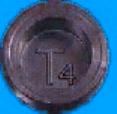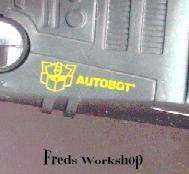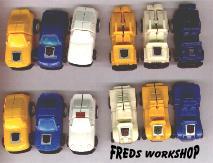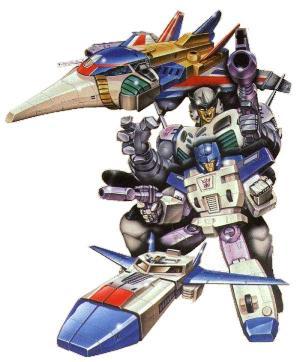

 What the heck does this all mean? Simple. Stampings are the manufacturer's logo and name molded into the plastic of the TF (Hasbro 198*). Rubsigns are the heat-sensitive rubsigns found on G1, Beast Wars, and reissue TFs. Why is this important? Well, not everyone can tell the difference between their original, G2, and reissue Jazz just by smelling it. ;-) Hopefully, the information contained here will help clarify other items on this site. :-)
|

|
Friends, Romans, Countrymen...this is a legitimate question for a lot of collectors. Not everyone is so obsessed that they can tell these things at a quick glance. Let's help them out! Molds have been reissued from day one of TFs. Transformers themselves, back in 1984, were technically reissued from Diaclone and other Pre-TF lines. Between the original line in the 80's, the reissue line in the 90's, and the new reissues line in the new millenium...well, there are a lot of toys to cover. :-) Let's start with the first split: G1 Toys Released In he G2 Line: There were a number of molds re-used from the G1 line for G2. These include: Optimus Prime, Sideswipe, Inferno, Jazz, the Constructicons, the Aerialbots, the Combaticons, and the Dinobots Slag, Snarl, and Grimlock. Now, some differences between generations are easy enough to tell apart simply by color. The Constructicons, for example, are green in G1, and yellow/orange for G2. But for some, especially Inferno, and the Dinobots, it's not such an easy call. The first-release of G2 Dinobots were the same color as G1 (later issues were red, green, etc). Luckily, there is one sure-fire way to make the call: the G2 units have their new faction symbol, and their affiliation name stamped somewhere on their bodies! Some are easy to find, some are not so easy, and some are deliberately hidden by the company so as to upset us. :-) Here's what each faction's G2 stamping will look like:
Some are right on the legs and windshields, while others have to be transformed to see it on the inside of their robot legs. Another, more subtle way to tell(one of those things the obsessed do) is to notice the color difference between the chrome on them. Of-course, the absolute best way to tell is by the *manufacturer stamping*. That's the little lettering molded into every Transformer (odds are, if it has no stamping, you have a knock-off). Most of this information is better clarified in the STAMPINGS section below, but the short version is: Original Transformers are stamped Takara Japan, or Hasbro-Takara Japnan (with 80's dates, such as 1984 on them). Later G1 toys are stamped Hasbro Takara-Macau (with similar 80's dates). Generation 2 Transformers are stamped Hasbro/Takara CHINA 1992. Yep, the date changed, as did the country. :-) Now, with the TRU Classics reissues, we have toys that are strikingly similar in design to G1 (some *are* taken off of the old molds/toys, after all, though others re backward-engineered G2 toys)...but in these cases, you can still tell. Most of these minute mold-changes between generations are discussed in more detail in their respective Autobot, Dinobot, and Decepticon sections...details such as color, mold, sticker, and weapon variations...however, again, the quickest way to tell is by manufacturer-stamping...in addition to Hasbro/Takara-CHINA, they also come with 2002 and beyond year stampings! Have a look! Hope this helps some. :-)
(Note: There was a Euro-Classic release (a 'tween line' of several of the G1 toys in the 1990s; not to be confused with the new TRU/Dreamwave releases. :-) The differences are covered on List One in the Japanese/European page.) |

|
The rubbies, as I like to call them, are the little rubsigns found on a substantial number of the Generation One Transformers. Basically, it's a little black square that, when you rub it, it reveals what faction your TF belongs to.
 They were first introduced on the Mini-Spy premiums that came with minibots. Mini-Spies came in 4 molds, three colors, with either a good guy rubby, or a bad guy rubby, for a total of 24 possible variations. Even more, if you count the variations between the wheelspokes. Man, these guys don't mess around...
Here's a pic of a G1 Jazz with, and without, the rubsign:
The minibots, same story. You can get the first two waves of the minibots either with a rubsign, without a rubsign, and in some cases with no faction symbol at all! This confusion brought to you courtesy of the rubsigns, and Hasbro. On most of the first few releases (1984, 85) the rubsign was simply affixed to a location on the toy. However, by 1986, Hasbro began to make changes to the molds of the new toys to accomodate the rubsign, as seen in the pic below:
In this case, the toy was designed to accomodate the rubsign, versus just slapping on the toy any old place. But NOTE that in the pic above, there is a difference in the molding between the toy with a rubsign, and the toy without...see it? You will find actual mold changes like this on most of the combiners, which is talked about in much detail in-you guessed it-the Combiners section! Rubsigns were eventually phased out of the G1 line after that point on. They make no appearance whatsoever in the G2 or Machine Wars line, but the concept is ressurected for the Beast Wars line of toys, with small Maximal and Predacon rubsigns, (now called energon chips by the manufacturer). Alas, these rubsigns, too, are phased out...by 1999, all the units come with a plastic molded insignia, (now called a "spark" crystal) which carries over into the Beast Machines line.
 For RID, there's nothing at all...just the normal painted symbols. However, at the start of the TRU reissues in 2002, we once again saw rubsigns. :-) These wotrk quite a bit better that their predecessors. For that matter, Delta makes some repro rubsigns too, if you want to replace yours. :-) Of-course, with the advent of reissue and repro rubsigns, the purposes of differentiating certain toys by their rub and pre-rub versions becomes somewhat moot, as more and more people decide to slap rubsigns on their toys. :-) That's why, in the end, the best way to tell them all apart is by manufacturer-stamping, covered in the next section below... |

|
It's this simple, Transformers came with a variety of stampings from the manufacturer, depending on what factory it came from, and when it was released. There are several catagories of stampings, and on average two, up to as many as five different types on EACH transformer! Take a look at the list of stampings you get to choose from (23 types and counting):
Imagine! All those different stampings to choose from...and of course, if you count the date changes (anything from 1974, 1979, upwards thru 80-84 and beyond, depending on import, leftover stock, or new manufacture, which can include Japanese writing along with the Takara stamping) you can practically DOUBLE the number of choices available to you. And this doesn't even COUNT the fact that you can have different LOCATIONS for the same stampings! Oh, what fun. And of course, with later series, when Japan was wiped out, and Macau put in its place...and then the reissues having China stamped on them...well, what can I say, except that the glories and fun continue... WHY did they change the stampings? Hehe. Well, here's the short version. It has to do with the original Pre-TF line of toys that the Transformers are made from. Toys such as Microman, Diaclone, etc were recycled from the Takara Corporation, and phased into the Hasbro Transformers line. At several points, old molds/overstock from those lines were used in America before these molds were fully retooled/replaced and the parts changed to accomodate Hasbro's use of them. That's why you have a Hound with a Takara-only stamping, versus a later Hound with a Hasbro-Takara stamping. In addition to WHEN a toy was produced, you have changes made to the stamping based on WHERE the toys were produced...Japan, China, Macau...even Brazil. :-) Many, many changes have occurred to the manufacturer-stampings over the decades...and we should be thankful for it. ;-) Because if they hadn't, we wouldn't be able to tell which version our Sideswipe was (Diaclone, G1, G2, Euro-Classic, or Reissue). More below!

|





